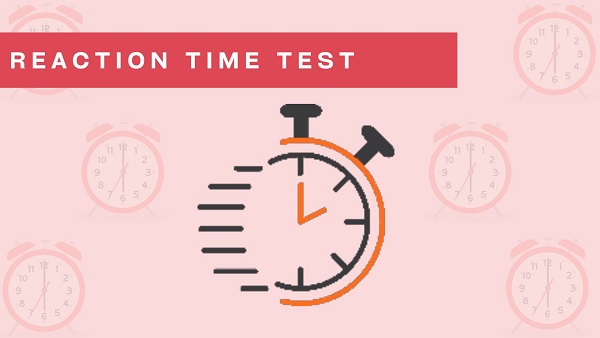Step into the Fascinating World of Reaction Time: Unraveling the Secrets behind Swift Responses!
Have you ever wondered how quickly you can react to a sudden stimulus? Reaction time is the key to swiftly responding to the world around us, whether it's catching a ball, avoiding an obstacle, or making split-second decisions. And human reaction time test is another key to discover about reaction time.
In this captivating
exploration, we will delve into the realm of reaction time, uncovering its
significance and shedding light on intriguing aspects of this fundamental
ability.
We'll start by
understanding what reaction time is and why it holds such importance in various
aspects of our lives. From sports performance to driving safety, reaction time
plays a vital role in our ability to succeed and navigate the world with
agility.
But how do we measure
reaction time? Discover the ingenious methods and tools utilized to capture and
analyze the swiftness of our responses.
Explore the science
behind reaction time measurement and gain insights into the fascinating
techniques employed by researchers and experts in the field.
As we delve deeper,
we'll uncover the diverse factors that can influence an individual's reaction
time. Age, gender, physical fitness, and even environmental factors can all
play a role in determining how swiftly we can react.
Join us as we unravel
the intricate interplay between these variables and gain a deeper understanding
of our own abilities.
Can we enhance our
reaction time through practice and training? That's a question we'll explore
next. Embark on a journey through the realms of neuroplasticity and skill
development as we delve into the potential for improving reaction time through
dedicated effort and targeted exercises.
So, get ready to dive
into the captivating world of reaction time. Strap in as we embark on a journey
to uncover the secrets behind swift responses, unmask the factors that shape
our reaction time, and explore the boundless possibilities of improving this
fundamental ability.
Importance of Reaction Time
Reaction time refers
to the interval between the presentation of a stimulus and the initiation of a
response. It is the measure of how quickly an individual can process
information and generate a motor response.
Reaction time is
vital in various aspects of our lives as it directly impacts our ability to
respond to stimuli in a timely manner.
In everyday
situations, such as driving, reaction time is crucial for avoiding accidents
and ensuring safety on the road. In sports, it can determine the outcome of a
game or competition, as athletes with faster reaction times have an advantage
in quickly anticipating and responding to opponents' movements. In emergency
situations, a swift reaction time can be the difference between life and death.
Furthermore, reaction
time is closely linked to cognitive functions such as attention, perception,
and decision-making. It reflects the efficiency of our nervous system in
processing sensory information and translating it into appropriate motor
responses.
By understanding and
improving our reaction time, we can enhance our overall cognitive abilities and
performance in various activities.
Reaction time is an
essential aspect of human performance, impacting our daily interactions,
safety, and success in different domains. By recognizing its significance, we
can appreciate the importance of assessing and enhancing our reaction time
abilities.
How is Reaction Time Measured?
Reaction time is typically measured using specialized tools or tests designed to assess the speed of response.
There are various methods employed to measure reaction time, depending on the specific context and purpose of the assessment.
Here are a few common approaches:
- Simple Reaction Time: This method involves responding to a single
stimulus with a specific action. For example, pressing a button as soon as a
light flashes. The time elapsed between the stimulus presentation and the
initiation of the response is measured.
- Choice Reaction Time: In this test, individuals are presented with multiple stimuli and are required to select the appropriate response based on each stimulus. The reaction time is measured for each choice made.
- Discrimination Reaction Time: This method assesses the time it takes to differentiate between different stimuli and respond accordingly. For instance, recognizing and reacting differently to a red light versus a green light.
- Computerized Tests: With advancements in technology, computerized tests have become popular for measuring reaction time. These tests often involve visual or auditory stimuli and require participants to respond using keyboards, mice, or touchscreens.
The measurement of
reaction time relies on precise timing equipment, such as electronic timers or
computer software, to accurately record the interval between the presentation
of a stimulus and the initiation of the response.
These measurements
provide valuable insights into an individual's processing speed and their
ability to react promptly to various stimuli.
Factors Affecting Reaction Time
Several factors can influence an individual's reaction time. Here are some common factors that can affect how quickly a person can respond to a stimulus:
- Age: Reaction time tends to slow down with age, as
neurological processes and muscle responses may become less efficient.
- Genetics: Certain genetic factors can contribute to
variations in reaction time among individuals. Some people may naturally have
faster or slower reaction times due to their genetic makeup.
- Physical fitness: A person's overall physical fitness level can
impact reaction time. Regular exercise and a healthy lifestyle can improve
cognitive function and promote faster reaction times.
- Sleep and fatigue: Lack of sleep or being fatigued can significantly
impair reaction time. Adequate rest and quality sleep are important for optimal
cognitive functioning and quick responses.
- Stimulus type: Different types of stimuli, such as visual,
auditory, or sensory cues, can elicit varying reaction times. Individuals may
have faster responses to certain types of stimuli based on their sensory
processing abilities.
- Distractions: External distractions or multitasking can slow
down reaction time. Divided attention between multiple tasks or environmental
factors can hinder the ability to respond quickly to a specific stimulus.
- Drugs and alcohol: Substance use, including alcohol and certain
medications, can negatively affect reaction time and impair cognitive
functions, leading to slower responses.
- Experience and training: Practice and training in specific activities or
tasks can improve reaction time through enhanced muscle memory, anticipation,
and improved decision-making abilities.
It's important to
note that while these factors can have an impact on reaction time, individuals
can work on improving their reaction time through various methods, such as
regular exercise, adequate rest, and targeted training exercises.
Improving Reaction Time by Practice and Training
Reaction time can be
improved through practice and training. While reaction time is influenced by
various factors, including genetic predisposition and age, it is also a skill
that can be honed and enhanced with deliberate practice. Here are some ways in
which reaction time can be improved:
- Specific reaction time exercises: Engaging in exercises that specifically target
reaction time can help improve the speed and efficiency of your responses. This
can include activities like playing reaction-based video games, using reaction
training tools, or participating in sports that require quick reflexes.
- Anticipation and prediction: By training your brain to anticipate and predict
certain stimuli or events, you can effectively reduce the time it takes to
initiate a response. This involves improving your focus, observational skills,
and understanding patterns or cues that precede certain actions.
- Cognitive training: Engaging in cognitive exercises and
brain-training activities can enhance cognitive processing speed and overall
mental agility, which can positively impact reaction time. These activities may
include puzzles, memory games, or problem-solving tasks.
- Physical fitness: Maintaining a good level of physical fitness can
contribute to improved reaction time. Regular exercise improves blood flow to
the brain, enhances neural connections, and promotes better cognitive function,
all of which can positively affect reaction time.
- Sleep and rest: Adequate sleep and rest are crucial for optimal
cognitive functioning, including reaction time. Getting enough quality sleep
allows your brain to recharge, leading to improved focus, alertness, and faster
responses.
- Stress management: High levels of stress can negatively impact
reaction time. Implementing stress management techniques, such as deep
breathing exercises, mindfulness, or relaxation techniques, can help reduce
stress and improve reaction time.
Remember, improving reaction time takes time and consistent effort. It is important to consult with professionals, such as trainers or coaches, who can provide tailored guidance and training programs to help you effectively improve your reaction time.



Comments
Post a Comment